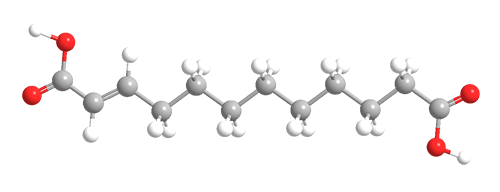What molecule am I?


Traumatic acid, formally trans-2-dodecenedioic acid, is a plant hormone that was isolated from damaged green beans by Caltech chemists James English, Jr., James Bonner, and A. J. Haagen-Smit in 1939. They describe traumatic acid and its acid–aldehyde cousin traumatin as “wound hormones” that is, substances produced by a plant to “heal” itself after it is damaged.
The same year, English et al. synthesized traumatic acid by converting undecylenic acid to the half-aldehyde of sebacic acid, which they then condensed with malonic acid in the presence of pyridine. CO2 was split off after the condensation, and the unsaturated diacid was isolated after hydrolysis of the ester group.
Traumatic acid may heal wounds in plants, but it may also be symbolic of American society’s wounds during this election season. May your trauma be kept to a minimum.

Learn more about this molecule from CAS, the most authoritative and comprehensive source for chemical information.
Molecule of the Week needs your suggestions!
If your favorite molecule is not in our archive, please send us a message. The molecule can be notable for its current or historical importance or for any quirky reason. Thank you!
Stay Ahead of the Chemistry Curve
Learn how ACS can help you stay ahead in the world of chemistry.

